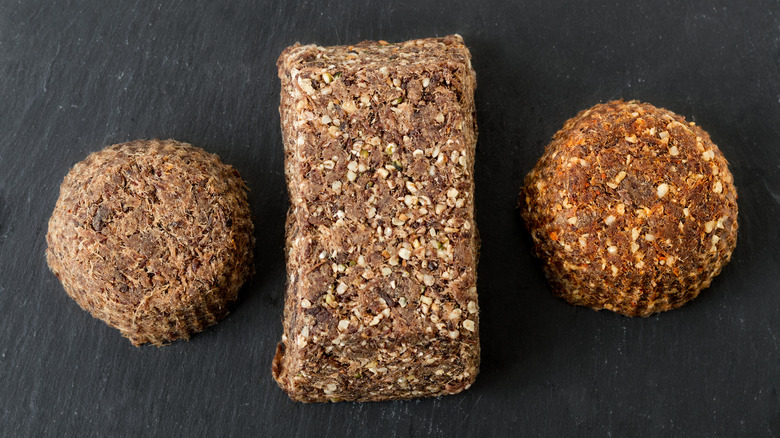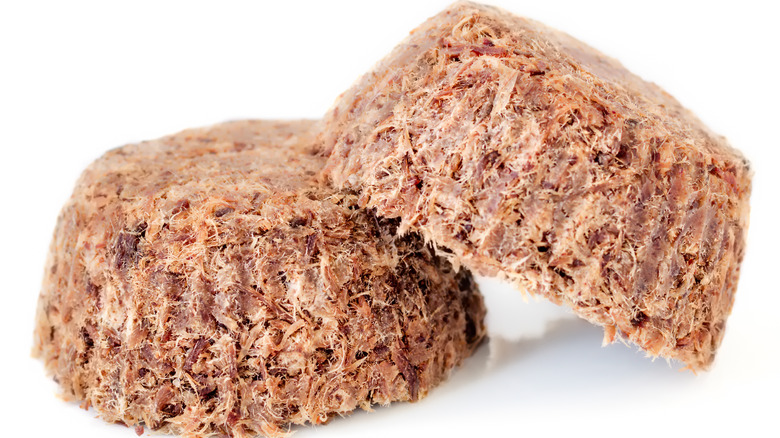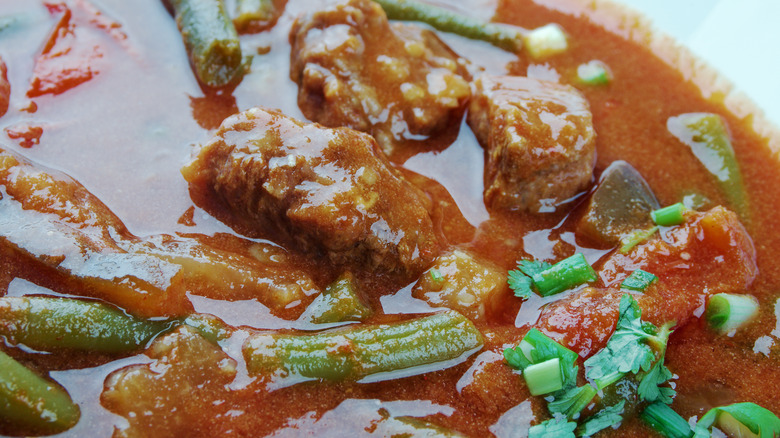Pemmican: The Ancient Indigenous Energy Bar That Lasts Years
Food serves many purposes beyond the basics: It can play with our emotions, evoke nostalgia, and bring families and friends together. But when the environment turns against you and resources grow scarce, food is brought down to its most fundamental role — fuel. With survival at stake, matters of taste become insignificant while energy and durability come to the forefront. An entire industry of energy bar brands has arisen to provide compact, long-lasting, calorie-dense snacks for camping expeditions (and mornings when you don't have the time to make anything better for breakfast), but centuries before that, there was pemmican. A staple of native Plains cultures like the Cree, Ojibwe, Blackfoot, and Sioux, Enoch Cree chef Shane Chartrand calls pemmican "a legit ancient indigenous energy bar" (via Atlas Obscura).
Archaeological evidence suggests that pemmican has been around since at least 2800 B.C., first used by nomadic cultures and later adopted by European colonizers in Canada. The Métis, a people descended from the offspring of French settlers and indigenous women, were particularly well-known for their pemmican, and became the principal suppliers to the fur-trading companies that sprung up throughout British-controlled Canada in the late 1700s. Pemmican was so popular that it was even adopted by some in Europe. Britannica recounts how early British expeditions to the Arctic were fueled by pemmican made in England. What was this almost magical substance, and why isn't it as popular today?
What is pemmican?
The name "pemmican" comes from the Cree word "pimikan," which means 'manufactured grease' (via Britannica). Don't worry, it's better than it sounds. Pemmican is traditionally made by pounding dried meat into a coarse powder and mixing it with an equal amount of melted animal fat. Berries, such as cranberries, cherries, currants, and blueberries, may also be thrown in the mix. The whole amalgam is then sewn into animal hide bags for storage and shipment. According to Atlas Obscura, a single pound of pemmican can pack as much as 3,500 calories, and it can last for years on end, making it the ultimate survivalist food. The key to pemmican's long shelf life is the fact that its ingredients are dehydrated; this protects the meat from spoilage because molds and bacteria need water to multiply (via Kansas State University).
Pemmican can be made from seemingly any type of meat along with its accompanying fat. Britannica lists moose, caribou, deer, and cattle as common sources. Kade M. Ferris of the Turtle Mountain Chippewa Heritage Center even writes of pemmican made by drying the flesh of sturgeon, mixing it with sturgeon oil, and packing it into sturgeon skin bags. However, bison (sometimes called "buffalo" in North America) was far and away the most common meat for making pemmican. According to Atlas Obscura, American bison almost went extinct in the late-1800s due to overhunting, and the steep decline in their numbers correlated to a decline in pemmican consumption.
Cooking with pemmican
As mentioned, Enoch Cree chef Shane Chartrand told Atlas Obscura, "pemmican is a legit ancient indigenous energy bar," and it's true that some people consumed it in the same way we eat nutrition bars: just biting off a chunk and marching onwards. This method garnered mixed reviews as far as taste was concerned. Chartrand reasons that, "some things are not meant to taste good; they're meant to make you survive," although it seems that some people legitimately enjoyed it. In the book, "Secrets of Polar Travel," Arctic explorer Robert Peary said that "a man can eat [pemmican] twice a day for three hundred and sixty-five days in a year and have the last mouthful taste as good as the first."
For those who weren't satisfied eating pemmican on its own, it could also be used as the base of a larger meal. Turtle Mountain Chippewa Heritage Center notes that pemmican was sometimes mixed with flour and fried, then served with bannock, a quick bread. However, the most popular pemmican-based meal was a type of stew called "rubaboo". According to the Métis Museum, rubaboo is made with pemmican and vegetables, typically corn and peas. Wild vegetation such as onions, parsnips, turnips, carrots, and mushrooms might also be used, as well as various regional herbs. Combine these with a bagful of pemmican in a pot of boiling water, then thicken it with flour or bread, and you've got a hearty meal to share with your traveling companions.


